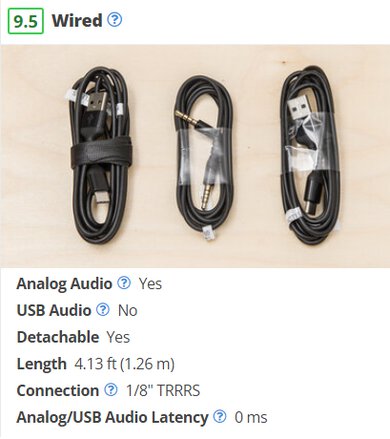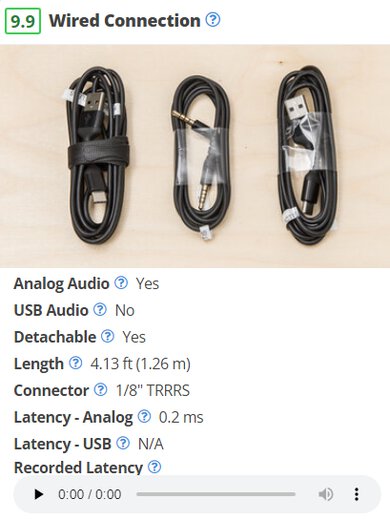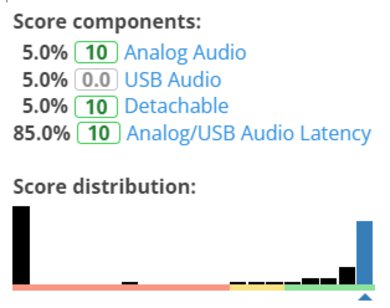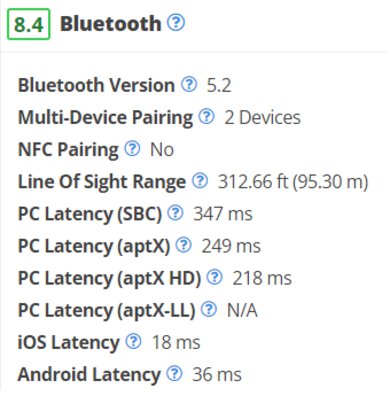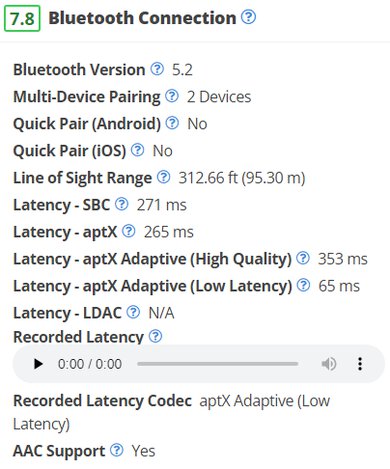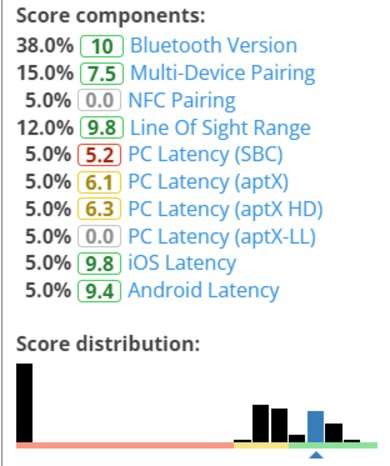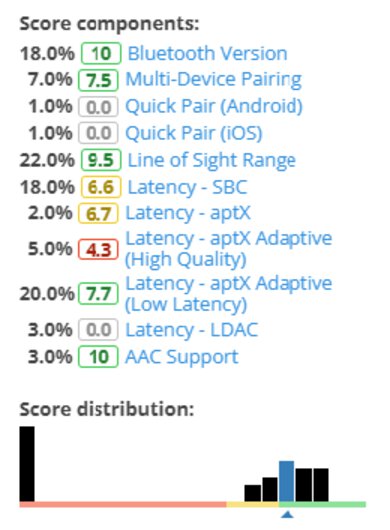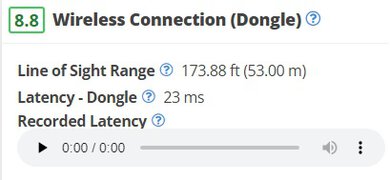See the previous 1.5 changelog.
See the next 1.7 changelog.
What's Changed?
One of the biggest changes we've made in this update is how we measure latency, whether that's via a wired connection, Bluetooth, or dongle. We've improved our latency methodology so that our results are more consistent and are a valid representation of what you'll experience when using these headphones. However, if you want all the nitty-gritty details, check out our R&D article, which explains our research and development process more in-depth.
Conversely, this page will give you an overview of what's been updated, so that you can find the right headphones for your needs. The following test groups have changed:
|
Test Group |
Description |
|
Wired Connection (previously called Wired) |
|
|
Bluetooth Connection (previously called Bluetooth) |
|
|
Wireless Connection (Dongle) (previously called Non-Bluetooth Wireless) |
|
WIRED CONNECTION
We've added a couple more new tests (in bold).
-
Analog Audio
-
USB Audio
-
Detachable
-
Length
-
Connector
-
Latency - Analog
-
Latency - USB
-
Recorded Latency
-
Recorded Latency Connection
Latency – Analog
While we previously had a latency measurement for this test group, it could be unclear whether this value was obtained via analog or USB. As a result, we've split up our measurements. You'll be able to clearly see the amount of latency you'll encounter when using an analog connection. Keep in mind that analog usually has extremely low to imperceptible latency. Good analog latency falls below five ms.
Latency – USB
Some headphones support USB audio; this is particularly common with gaming headsets and headphones with a built-in DAC (Digital Audio Converter). As a result, you'll want to know how much latency this connection has. We consider latency values under 50 ms good, but latency can be noticeable with 30 ms or more delay, depending on your sensitivity.
Recorded Latency
This is a file that allows you to hear latency for yourself. The reference audio track is played alongside the delayed headphones output.
|
|
|
|
The Focal Bathys Wireless have high latency via analog (35.5 ms). |
The Audio-Technica ATH-M50x have low latency via analog (0.2 ms). |
Recorded Latency Connection
This lets you know which connection we've used to measure recorded latency.
|
The SteelSeries Arctis Nova Pro Wireless' Wired test results on TB. 1.5. |
The SteelSeries Arctis Nova Pro Wireless' Wired Connection test results on TB 1.6. |
Score Component Weights
In addition to these changes, Wired Connection's scoring component weight has also been modified due to the separation of Analog/USB Audio Latency into Latency – Analog and Latency - USB:
|
The Steel Series Arctis Nova Pro Wireless' Wired Connection breakdown on TB 1.5. |
The Steel Series Arctis Nova Pro Wireless' Wired Connection breakdown on TB 1.6. |
Bluetooth Connection
We've added the following tests:
-
Quick Pair (Android)
-
Quick Pair (iOS)
-
Line of Sight Range
-
Latency - aptX Adaptive (High Quality)
-
Latency - aptX Adaptive (Low Latency)
-
Latency - LDAC
-
Recorded Latency
-
Recorded Latency Codec
-
AAC
We've removed aptX HD Latency, aptX-LL Latency, and NFC Pairing. The rise of aptX Adaptive resulted in the phasing out of aptX-LL. aptX HD has also become less common in favor of Adaptive. Similarly, while NFC chips were common a couple of years ago, this technology Is being implemented less and less. We'll still report if a pair of headphones supports these features.
We've also removed iOS Latency and Android Latency. Our methodology was different for these tests compared to the rest of our latency tests, which meant that these results weren't directly comparable. Measurements could also be specific to the phone model or to an OS version or app version, which means our results may not be valid for other devices.
Quick Pair (Android)
This test shows whether you can quickly pair the headphones with an Android device using a feature like Swift Pair or Google Fast Pair.
Quick Pair (iOS)
Like Quick Pair (Android), this test shows if the headphones can be quickly paired with iOS devices. This can be in the form of an H1/H2 or W1/W2 chip that's commonly found in Apple headphones (and some Beats products).
Latency – LDAC
LDAC is a proprietary codec owned by Sony. While not all headphones support it, you may want this codec if you want to stream audio in higher quality over Bluetooth. However, by its nature, it tends to have high latency, so it's best suited for audio listening, rather than video or gaming.
Recorded Latency
This is an audio file that represents the highest amount of latency of the connections. This allows you to hear the headphones' latency via Bluetooth.
|
|
|
|
The Sony WH-1000XM5 Wireless have high latency (241 ms) via SBC codec. |
The Razer Barracuda Pro Wireless have a better latency via SBC codec (113 ms). |
AAC Support
AAC (advanced Audio Coding) is the default standard audio format for iOS devices among apps and devices like YouTube Music. It's a standard for lossy digital audio compression, and many regard it as a better alternative to the default SBC codec. Unfortunately, when investigating AAC, we measured a wide difference between operating systems, and aren't currently able to measure its latency well. You can read our investigation into this audio format here. As a result, this test only checks whether the headphones support AAC with a 'Yes/No' result.
|
The Sennheiser MOMENTUM 4 Wireless' Bluetooth test results on TB 1.5. |
The Sennheiser MOMENTUM 4 Wireless' Bluetooth Connection test results on TB 1.6. |
Score Component Weights
Bluetooth Connection's score component weighting has also changed. This is to better reflect the value of each of the codecs. You can see the breakdown below:
|
The Sennheiser MOMENTUM 4 Wireless' Bluetooth Connection breakdown on TB 1.5. |
The Sennheiser MOMENTUM 4 Wireless' Bluetooth Connection breakdown results on TB 1.6. |
Wireless Connection Dongle
This test replaces the Non-Bluetooth Wireless test, adding a recorded latency file.
|
|
|
|
The Bowers & Wilkins Pi7 S2 True Wireless have bad latency via their wireless transmitter carrying case (266 ms). |
The Audeze Maxwell Wireless have good latency via their dongle (23 ms). |
|
The Audeze Maxwell Wireless' Non-Bluetooth Wireless test results on TB 1.5. |
The Audeze Maxwell Wireless' Wireless Connection (Dongle) test results on TB 1.6. |
It's important to note that unlike 'Wired Connection' or 'Bluetooth Connection', the score breakdown for this test hasn't changed.
Let Us Know What You Think!
We're always looking to improve our work; if there's something you'd like us to add or investigate, please let us know in the forums. Your feedback helps us create better tests and data!
100 Headphones Updated
We have retested popular models. The test results for the following models have been converted to the new testing methodology. However, the text might be inconsistent with the new results.
- 7HZ Timeless
- AKG K371
- AKG K702
- AKG N700NC M2
- Anker Soundcore Liberty 4 NC Truly Wireless
- Anker Soundcore Life Q20 Wireless
- Anker Soundcore Life Q30 Wireless
- Anker Soundcore Space A40 Truly Wireless
- Anker Soundcore Space Q45 Wireless
- Apple AirPods (3rd generation)
- Apple AirPods Max
- Apple AirPods Pro 2
- Astro A20 Gen 2 Wireless
- Astro A40 TR Headset + MixAmp Pro 2019
- Astro A50 Gen 4
- Audeze Maxwell Wireless
- Audio-Technica ATH-M50x
- Bang & Olufsen Beoplay Portal
- Beats Studio Buds True Wireless
- Beats Studio Pro Wireless
- Beyerdynamic DT 700 PRO X
- Beyerdynamic DT 770 PRO
- Beyerdynamic DT 990 PRO
- Bose 700 Headphones Wireless
- Bose QuietComfort 35 II Gaming Headset
- Bose QuietComfort 45/QC45 Wireless
- Bose QuietComfort Earbuds II Truly Wireless
- Bose QuietComfort Headphones Wireless
- Bose QuietComfort Ultra Earbuds Truly Wireless
- Bose QuietComfort Ultra Headphones Wireless
- Bowers & Wilkins Pi7 S2 True Wireless
- Bowers & Wilkins Px7 S2 Wireless
- Bowers & Wilkins Px8 Wireless
- Drop + Sennheiser/EPOS PC38X
- EarFun Air Pro 3 True Wireless
- Focal Bathys Wireless
- Google Pixel Buds Pro
- HiFiMan Arya
- HiFiMan Arya Stealth Magnet Version
- HiFiMan Edition XS
- HiFiMan HE400se
- HiFiMan Sundara 2020
- HyperX Cloud 2/Cloud II
- HyperX Cloud Alpha
- HyperX Cloud Alpha Wireless
- HyperX Cloud III
- HyperX Cloud III Wireless
- Jabra Elite 10
- Jabra Elite 8 Active
- JBL Tune 760NC
- JBL Vibe Beam True Wireless
- Logitech G PRO X 2 LIGHTSPEED Wireless
- Logitech G Pro X Gaming Headset
- Logitech G PRO X WIRELESS LIGHTSPEED Gaming Headset
- Logitech G435 LIGHTSPEED Wireless
- Logitech G535 LIGHTSPEED Wireless
- Logitech G733 LIGHTSPEED Wireless
- MOONDROP Blessing 3
- Philips Fidelio X2HR
- Philips SHP9500
- Philips SHP9600
- Razer Barracuda Pro Wireless
- Razer Barracuda Wireless
- Razer Barracuda X Wireless 2021
- Razer BlackShark V2
- Razer BlackShark V2 HyperSpeed Wireless
- Razer BlackShark V2 Pro Wireless 2023
- Razer Hammerhead Pro HyperSpeed True Wireless
- Razer Kraken V3 Pro Wireless
- Samsung Galaxy Buds FE
- Samsung Galaxy Buds2 Pro
- Sennheiser HD 450BT Wireless
- Sennheiser HD 560S
- Sennheiser HD 600
- Sennheiser HD 660S2
- Sennheiser HD 6XX
- Sennheiser HD 800 S
- Sennheiser MOMENTUM 4 Wireless
- Sennheiser MOMENTUM True Wireless 3
- Shure AONIC 50 Gen 2 Wireless
- Sony LinkBuds S Truly Wireless
- Sony MDR-7506
- Sony PULSE 3D Wireless
- Sony WF-1000XM4 Truly Wireless
- Sony WF-1000XM5 Truly Wireless
- Sony WH-1000XM3 Wireless
- Sony WH-1000XM4 Wireless
- Sony WH-1000XM5 Wireless
- Sony WH-CH720N Wireless
- Sony WH-XB910N Wireless
- SteelSeries Arctis 7X Wireless
- SteelSeries Arctis 9X Wireless
- SteelSeries Arctis Nova 7 Wireless [7, 7P, 7X]
- SteelSeries Arctis Nova Pro
- SteelSeries Arctis Nova Pro Wireless [PC, PS, Xbox]
- SteelSeries Arctis Pro Wireless
- Superlux HD 681
- TRUTHEAR x Crinacle ZERO
- Turtle Beach Stealth Pro Wireless
- Xbox Wireless Headset
